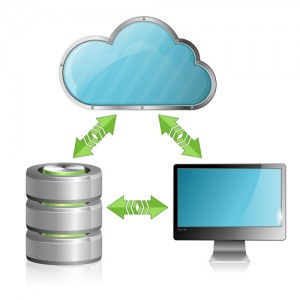Making Online Communication More Efficient with WebRTC
 As time has passed, business communications have become much more simplified. Voice and video conferencing have recently developed to the point where separate applications aren’t even required, allowing users to communicate instantly right through their browser.
As time has passed, business communications have become much more simplified. Voice and video conferencing have recently developed to the point where separate applications aren’t even required, allowing users to communicate instantly right through their browser.
Web Real-Time Communication, or WebRTC, is a potentially revolutionary online communication technology. As its name implies, it is intended to allow people to communicate instantly through a web browser rather than requiring the installation of extensions, plugins, or outside applications. Because of this, WebRTC could make business communications much more efficient for those with certain device or browser limitations. There are a number of benefits that WebRTC offers for businesses.
Increased Focus on the User
What might be the biggest benefit of WebRTC is its user-friendliness. WebRTC eliminates the limitations of applications, plugins, and extensions, and gives users the ability to communicate with each other more easily and universally, with a single solution that offers voice, video and chat capabilities.
Improved Customer Interaction
Another advantage of WebRTC is its ability to enhance customer engagement. Customers don’t have to download other programs or pay for communication services when they can simply use whatever browser they want to contact a tech support employee or other staff. Instant messaging, voice calls, and video calls are all located in a central hub.
Screen sharing is another capability that makes customer service even easier, as customers can share what they’re seeing and vice versa. Adding this technology to an online store can also be extremely helpful when customers want additional information about a product or service, enabling them to communicate with staff on the same platform as the store itself.
Complete Versatility
“Contact me” buttons and other types of calls to action can connect WebRTC with many different aspects of communication. Businesses can successfully implement it on nearly every facet of their company’s online presence, putting them in even closer contact with consumers.
Lowered Costs and Saved Time
The ability to place all methods of online communication on a single platform means that paying for multiple programs is no longer necessary. Companies only have to pay for a single solution, and it can also be a core part of a Software as a Service (SaaS) application. Ultimately, businesses will save time and money when their communication methods are located in one place.
More Opportunities for the Telecom Industry
WebRTC can also be a huge asset for the telecom industry. Telecom companies can develop a new business model to replace models for other, more traditional telecommunications applications, thus helping them transition into the new era of cloud technology.
WebRTC is beneficial in these and other ways as it continues to develop, making business communications more efficient and less expensive.
Why SMBs are Turning to UCaaS
 The hosted unified communications (UC), or Unified Communications as a Service (UCaaS), market continues to expand as the technology develops. Small and medium businesses (SMBs) are those most likely adopt this service. The desire to use UCaaS is logical for SMBs because of their need for mobility, as they often employ sales teams and other employees who spend a lot of time in the field.
The hosted unified communications (UC), or Unified Communications as a Service (UCaaS), market continues to expand as the technology develops. Small and medium businesses (SMBs) are those most likely adopt this service. The desire to use UCaaS is logical for SMBs because of their need for mobility, as they often employ sales teams and other employees who spend a lot of time in the field.
At the same time, SMBs typically have smaller IT teams that may struggle to meet the technological needs of the company. In order to meet these demands, hosted cloud services are ideal. There are several benefits smaller enterprises experience when switching to UCaaS.
Increased Productivity and Technological Capabilities
One of the main advantages of UCaaS is the ability for SMBs to operate much like their larger, corporate competitors by using state-of-the-art technology that allows employees to easily connect with coworkers, customers, and business partners. UCaaS allows remote employees to conduct business as if they were operating out of a local office. Rather than waiting for email responses, instant messaging capabilities allow for real-time questions and updates. Many companies don’t even make phone calls anymore unless they absolutely have to, since UCaaS provides efficient communication methods that replace voice communications.
For businesses that do rely on voice communications, UC can include features such as “Find Me/Follow Me” that put calls through to multiple people until someone available can answer. A hosted UC solution can also transcribe voicemail messages and provide links to audio for employees’ convenience.
Streamlined Administration and Deployment
Another benefit of a hosted UC solution is increased efficiency of administration and deployment. If a company’s internal network is capable, businesses can make a full transition to hosted UC within weeks of implementation. Employees can download necessary apps on pre-programmed mobile devices, giving workforces all of the tools they need to run operations smoothly. Employees and employers can use a web portal to centralize administration operations, with custom profiles that make it easy for each person to use.
Improved Finances
Hosted UC offers customers a simple, reasonable monthly OpEx charge and eliminates the costs of integrating the new Session Initiation Protocol (SIP) trunks, private branch exchange (PBX), and Session Border Controllers (SBCs) that are normally required. There’s no need for third party video conferencing or other solutions, because they’re included with UCaaS. A/V collaboration is also included in the final price, along with regular and long distance calling.
Improved Coworker and Customer Collaboration
Online collaboration is another element that’s simplified with UCaaS. People can communicate with each other from any location. If someone is traveling for a business meeting miles away from the office and needs more information from a certain department, he or she can simply use a private audio or video conferencing solution to bring the other, more knowledgeable colleague into the meeting instantly.
These are just several of the many benefits that make switching to UCaaS an invaluable decision for any business.
Don’t Write off a Business Phone System Just Yet
 Thanks to technology, land lines have disappeared across much of America. This trend began in the residential space and was quickly followed by businesses abandoning their traditional telephone services. Voice over IP (VoIP) has swooped in as their state-of-the-art replacement, boasting customer relationship management (CRM) integration tools, automated routing, call handling, and sophisticated reporting and monitoring functions. Phone systems have come a long way, and they now serve many more purposes than just making calls. Before making the decision to abandon the company phone system, consider the following points.
Thanks to technology, land lines have disappeared across much of America. This trend began in the residential space and was quickly followed by businesses abandoning their traditional telephone services. Voice over IP (VoIP) has swooped in as their state-of-the-art replacement, boasting customer relationship management (CRM) integration tools, automated routing, call handling, and sophisticated reporting and monitoring functions. Phone systems have come a long way, and they now serve many more purposes than just making calls. Before making the decision to abandon the company phone system, consider the following points.
Phone Systems and Customer Service
Thanks to the Internet, collaboration tools have never been more plentiful. Free conference calling, webinars, video chat, IM, and other online communications tools make the world a much smaller place and allow geographically dispersed teams to communicate as if they are only cubicles away.
Since there are so many available software options for communication, it’s easy to see how compatibility problems can arise. Utilizing different pieces of software may work for staff members, but that won’t always be the case when working with clients. Even for tech-savvy customers, it always seems like a plugin, system update, or forgotten password is in the way of getting urgent help. Less technically inclined customers may become so frustrated that they take their business elsewhere. In contrast, using a VoIP phone system is an easy way to support customers and provide them with the excellent service they demand.
The Benefits of an Inbound Phone Line
A business may not need to make outbound phone calls, but providing an inbound phone line can be useful in several ways.
- Customer service is enhanced by providing voice-to-voice contact (which is a luxury today).
- Listing a personal cell phone number to handle business calls is not always desirable.
- Having a professional business phone line generates trust and provides accessibility to quality customer service, which can be a differentiator in a congested marketplace.
Phone System ROI
One of the chief complaints about phone systems is the significant expense to acquire, maintain, and add to them. Fortunately, VoIP has made calling very inexpensive (down to a few pennies per minute), and plans can be tailored to a business’s expected volume. Whether personnel need to make one or one hundred calls per day, there is a plan on the market to fit that requirement. Many phone system plans also allow intracompany calling for free using Session Initiation Protocol (SIP) trunking.
For a reasonable cost, a company can have a sophisticated phone system with many valuable problem-solving features. Even better, hosted systems may perform all functions through software, with no expensive phone equipment needed. With increased customer loyalty and company growth, the ROI could be exponential.
Forgoing a phone system may save money in the short term, but ultimately it can be an expensive decision. VoIP systems are a great way to provide the communications staple needed for customer convenience while keeping the bill and equipment affordable. Before walking away from a potentially effective solution, research the available plans. The affordability and flexibility of today’s options make them well worth consideration.
Why BaaS Is Becoming Tomorrow’s Standard in Data Storage
 Using the cloud for secure Backup as a Service (BaaS) data storage is rapidly becoming a quality that potential clients look for when evaluating business partners. In a high energy business environment with ever increasing dependency on information and data storage, the consequences of data loss can be catastrophic.
Using the cloud for secure Backup as a Service (BaaS) data storage is rapidly becoming a quality that potential clients look for when evaluating business partners. In a high energy business environment with ever increasing dependency on information and data storage, the consequences of data loss can be catastrophic.
How It Works
Online backup systems operate by using agent software to compress designated data files, folders, and drives, then encapsulate the compressed data in encrypted packets and transmit them to an off-site facility where the data is stored.
The initial backup can be time consuming, but in subsequent sessions backup systems save bandwidth and time by using algorithms to scan the selected folders and drives and focus only on data files that have been added or changed since the last update.
In-House Backup Difficulties
Backing up data is nothing new in the business world. Traditionally it has been a function performed as time allowed by IT professionals within the company, and the data was stored on location. There are a number of drawbacks to this method. Three of the more prevalent are:
- cost of IT personnel,
- cost of equipment, and
- potential for total data loss.
Online backup systems provide viable solutions via the cloud to each of these persistent problems with in-house data backup.
Labor Savings
Once the agent software has been installed, the company’s IT professionals need only designate the material to be backed up and schedule a recurring time window for the backup to take place. After that, the process becomes automatic. No further active participation is needed on the part of employees. The result is less manpower and less labor cost.
Infrastructure Savings
The savings in equipment cost is immediately obvious. Eliminating the need to purchase, keep, and continuously update data storage equipment translates to a great deal of savings even after the cost of the online backup is taken into account.
Reduced Risk of Total Loss
One of the more often overlooked advantages of online backup is the reduction of total data loss risk. When data is backed up and kept on location, the original data and the backed up data are both at risk if the building is somehow destroyed. If the backup data is stored off-site, as is the case with an online backup system, the destruction of the business building does not mean that all of the business’s vital data is forever gone.
Looking Forward to BaaS and the Cloud
Any enterprise that does business over many years will learn that suffering data loss is inevitable. The deciding factor between data loss being a mere inconvenience or a serious financial disaster will depend on how well prepared a company is for the problem.
It should be noted that as the business field of play changes, the cloud becomes more essential in daily operations. Businesses that fail to adapt to the ever increasing influence of the cloud will find themselves left behind. Existing and prospective clients are becoming more conscious of whom they do business with. In increasing numbers, potential businesses are looking at survivability when choosing their partners.
The Ever-Evolving VoIP
 The birth cry of the Internet came about in the U.S. when the Advanced Research Projects Agency Network (ARPANET) delivered the first data packet between two computers in 1969. That very same ARPANET saw the birth of Voice over Internet Protocol (VoIP) when the first data packet of encoded voice was transmitted in 1974. In recent years, the dawning and proliferation of the information age has seen VoIP truly come into its own.
The birth cry of the Internet came about in the U.S. when the Advanced Research Projects Agency Network (ARPANET) delivered the first data packet between two computers in 1969. That very same ARPANET saw the birth of Voice over Internet Protocol (VoIP) when the first data packet of encoded voice was transmitted in 1974. In recent years, the dawning and proliferation of the information age has seen VoIP truly come into its own.
An Innovation in the Data World
From businesses to the home internet connection, relatively inexpensive high speed internet is allowing VoIP to replace traditional telephone services. In all but the most remote rural areas, sufficient internet speeds are now available, prompting consumers to question the need for both telephone and internet services when internet will serve both voice and data functions.
Affordability and Convenience
In the past there has been resistance to innovations such as VoIP due to cost and the dread of having to get a new telephone number. That is no longer the case. VoIP equipment is highly affordable and often is less costly than even an average smartphone. Further, the cost of transmitting a data packet over long distance is hardly more than the cost to send the same data packet across the room, making VoIP more affordable than traditional long distance telephone services.
In the early days, a VoIP call had to go through a third party because telecommunications companies held a certain level of propriety over the connections. Now, VoIP calls go directly to the recipient, bypassing the middleman and keeping costs low.
Changes in FCC laws now allow phone numbers to be transferred from one service to another. The process of making the change takes just moments, and the service provider is usually happy to do the work in order to get new business. The service itself is has yearly costs comparable to regular monthly cellular phone charges.
Services That Are Part of the Package
Most VoIP packages include long distance as just another service provided for a very low single fee if not provided entirely for free. A number of services once considered to be extras were billed as such but are now being provided by VoIP as a standard package. Some of these standard services provided at little to no additional cost include call forwarding, voicemail, and call waiting.
Marrying VoIP to Apps
VoIP is IP-based and highly adaptable with regard to data handling applications. As a result, VoIP telephony systems are capable of previously unheard of functions and new applications are arriving on the scene every day. From screen sharing to faxing to email, the IP-based world is growing and expanding in capabilities at a mind-boggling rate. With the affordability of VoIP services being realized, what was once thought to be a tool for businesses has taken root in the home.
